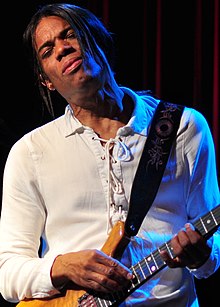
In musical instrument classification, string instruments or chordophones, are musical instruments that produce sound from vibrating strings when a performer plays or sounds the strings in some manner.

Stanley Clarke is an American bassist, composer and founding member of Return to Forever, one of the first jazz fusion bands. Clarke gave the bass guitar a prominence it lacked in jazz-related music. He is the first jazz-fusion bassist to headline tours, sell out shows worldwide and have recordings reach gold status.

Tapping is a playing technique that can be used on any stringed instrument, but which is most commonly used on guitar. The technique involves a string being fretted and set into vibration as part of a single motion. This is in contrast to standard techniques that involve fretting with one hand and picking with the other. Tapping is the primary technique intended for instruments such as the Chapman Stick.
The fingerboard is an important component of most stringed instruments. It is a thin, long strip of material, usually wood, that is laminated to the front of the neck of an instrument. The strings run over the fingerboard, between the nut and bridge. To play the instrument, a musician presses strings down to the fingerboard to change the vibrating length, changing the pitch. This is called stopping the strings. Depending on the instrument and the style of music, the musician may pluck, strum or bow one or more strings with the hand that is not fretting the notes. On some instruments, notes can be sounded by the fretting hand alone, such as with hammer ons, an electric guitar technique.

A fretless guitar is a guitar with a fingerboard without frets, typically a standard instrument that has had the frets removed, though some custom-built and commercial fretless guitars are occasionally made. The classic fretless guitar was first pioneered in 1976 by Turkish musician Erkan Oğur. Fretless bass guitars are readily available, with most major guitar manufacturers producing fretless models.

Jazz bass is the use of the double bass or electric bass guitar to improvise accompaniment ("comping") basslines and solos in a jazz or jazz fusion style. Players began using the double bass in jazz in the 1890s to supply the low-pitched walking basslines that outlined the chord progressions of the songs. From the 1920s and 1930s Swing and big band era, through 1940s Bebop and 1950s Hard Bop, to the 1960s-era "free jazz" movement, the resonant, woody sound of the double bass anchored everything from small jazz combos to large jazz big bands.

Kenny Garrett is an American post-bop jazz musician and composer who gained recognition in his youth as a member of the Duke Ellington Orchestra and for his time with Miles Davis's band. His primary instruments are alto and soprano saxophone and flute. Since 1985, he has pursued a solo career.
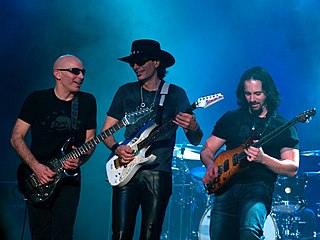
Shred guitar is a virtuosic style of electric guitar performance. Categorized by its use of advanced techniques, shredding is a complex art form. Shred guitar includes fast alternate picking, sweep-picking, diminished and harmonic minor scales, tapping, and whammy bar use. Often incorporated in heavy metal, guitarists employ a guitar amplifier and a range of effects such as distortion. This creates a sustained guitar tone and may facilitate guitar feedback.
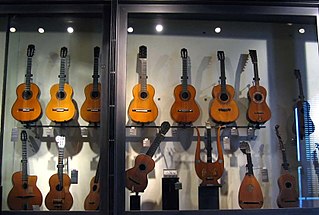
The following outline is provided as an overview of and topical guide to guitars:

Charnett Moffett was an American jazz bassist. A consummate and versatile bassist, and composer, he was an apparent child prodigy. Moffett began playing bass in the family band, touring the Far East in 1975 at the age of eight. In the mid-1980s, he played with Wynton Marsalis and Branford Marsalis.

Cyrus Chestnut is an American jazz pianist, composer and producer. In 2006, Josh Tyrangiel, music critic for Time, wrote: "What makes Chestnut the best jazz pianist of his generation is a willingness to abandon notes and play space."
Kenny Drew Jr. was an American jazz pianist. His music is known for its hard-swinging bluesy sound and large, two-handed rooty chords contrasting with fast runs. The son of jazz pianist Kenny Drew, he did not credit his father as an influence.
Finger vibrato is vibrato produced on a string instrument by cyclic hand movements. Despite the name, normally the entire hand moves, and sometimes the entire upper arm. It can also refer to vibrato on some woodwind instruments, achieved by lowering one or more fingers over one of the uncovered holes in a trill-like manner. This flattens the note periodically creating the vibrato.

I Wayan Balawan, better known by the single name Balawan, is an Indonesian guitarist and songwriter. He is best known for his ability to play double neck guitar. Balawan has developed the 8 Fingers Touch Style technique, which also known as the Touch-Tapping Style. He is often regarded as one of the fastest guitarists in Indonesia. He is also called the Magic Finger guitarist.

A guitar synthesizer is any one of a number of musical instrument systems that allow a guitarist to access synthesizer capabilities.
Jazz guitarists are guitarists who play jazz using an approach to chords, melodies, and improvised solo lines which is called jazz guitar playing. The guitar has fulfilled the roles of accompanist and soloist in small and large ensembles and also as an unaccompanied solo instrument.
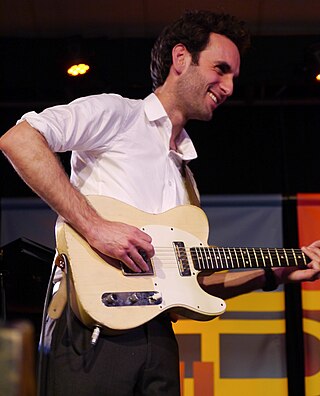
Julian Lage is an American guitarist and composer.

Magic Touch is the first studio album by guitarist Stanley Jordan, released in 1985 by Blue Note Records on vinyl; a CD edition was issued in 1990.
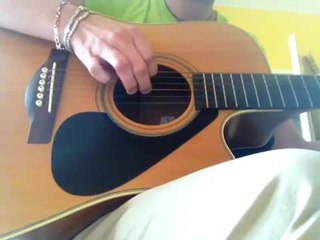
Guitar picking is a group of hand and finger techniques a guitarist uses to set guitar strings in motion to produce audible notes. These techniques involve plucking, strumming, brushing, etc. Picking can be done with:

Motéma Music is a jazz and world music record label in the United States. It was founded in 2003 in San Francisco Bay Area by label president and recording artist Jana Herzen. The label has received Grammy recognition more than 25 times for albums in jazz, Latin jazz, reggae, and R&B. Motema's roster includes Gregory Porter, Joey Alexander, Deva Mahal, Pedrito Martinez, Randy Weston, Geri Allen, David Murray, Monty Alexander, and Charnett Moffett, Donny McCaslin, Mark Guiliana, and Terri Lyne Carrington and many other respected artists in jazz, world and soul music.
